Kristine Hughes's Blog, page 96
February 28, 2014
The Wellington Tour: Exciting Changes!
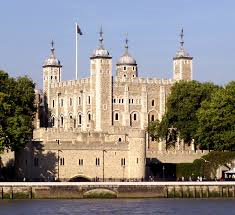
Not so long ago, Victoria and I believed that we had the itinerary for The Wellington Tour finalized and that it was done and dusted, but instead we're finding that it's a fluid, ever evolving thing. One could even say that it's got a life of its own. I recently received an email from an English Heritage curator at the Tower informing Victoria and me that they were going to be mounting an exhibition this summer on the Duke of Wellington's influence upon and changes to the Tower made whilst he was both Constable of the Tower and Prime Minister.
While we don't have complete details regarding the Exhibition as yet, Victoria and I deemed it important that we take it in during The Wellington Tour in September. Accordingly, we have changed the itinerary by substituting the Tower of London for St. Paul's Cathedral on Saturday, September 6th. Until further details arrive, you can read on to learn more about Wellington's influence on the Tower of London.
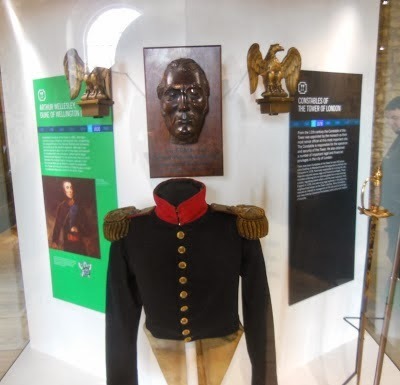
Above - Items belonging to the Duke of Wellington shown previously at the Tower. Read more here.
From the Tower of London website:
The Duke of Wellington was Constable of the Tower from 1826 to 1852. Under his invigorating leadership the increasingly smelly and sluggish moat was drained and converted into a dry ditch.
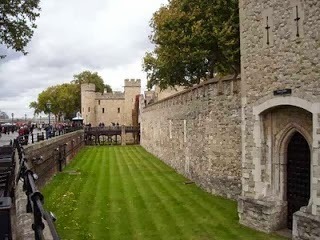
The Grand Storehouse was destroyed by fire in 1841. The Duke arranged to clear the rubble and started work on a huge new barracks, to accommodate a thousand men. On 14 June 1845 the Duke laid the foundation stone on the barracks named after his greatest victory – Waterloo.
London 1840s was the scene of rallies and disturbances by Chartists demanding electoral reform. The Tower exerted its traditional role of state power over the people, probably for the last time. More defences were constructed, including a huge brick and stone bastion that finally succumbed to a Second World War bomb, but the Chartist attack never materialised.
It was also at the beginning of this century that many of the Tower’s historic institutions departed. The Royal Mint was the first to move out of the castle in 1812, followed by the Menagerie in the 1830s, which grew to become London Zoo. The Office of Ordnance was next to leave in 1855 and finally, the Record Office relocated in 1858. An increasing interest in the history and archaeology of the Tower led to a process of ‘re-medievalisation’ in an attempt to remove the unsightly offices, storerooms, taverns, and barracks and restore the fortress to its original medieval appearance.

Visitor numbers increased dramatically in the 19th century. now it was not just privileged sightseers (who were paying for a guided tour as early as the 1590s), but ordinary people who enjoyed a day out at the Tower. In 1838 three of the old animal cages from the Menagerie were used to make a ticket office at the eastern entrance where visitors could buy refreshments and a guidebook. By the end of Queen Victoria’s reign in 1901, over half a million people were visiting the Tower each year.
You can find more details about The Duke of Wellington Tour here.
Read on for an account of the ceremony swearing in the Duke of Wellington as constable of the Tower from The Life and Campaigns of Arthur, Duke of Wellington by George Newenham Wright (1841) by clicking here.
And you can see almost daily pictures of the Tower ravens posted by Ravenmaster on Twitter by clicking here. Black and white photo above (Beefeaters at Tower gate) also supplied by same.

Published on February 28, 2014 00:00
February 26, 2014
Video Wednesday - Dancing

Midnight Revels - New Year's Eve 1949, Albert Hall
Cleaning Ladies' 13th Annual Ball 1960, Walworth Road, London
Aristocrats at a "Gay Nineties" party, London 1933
and on a more contemporary note
The Big Dance Royal Flashmob at Buckingham Palace
Goofy guys doing the Hobo Dance in front of Horse Guards
and in marked contrast, here's Tom Hiddleston dancing.

and Tom Hiddleston dancing again.
Happy Wednesday!
Published on February 26, 2014 00:00
February 24, 2014
Lunch with Author Loretta Chase

This past Saturday, I had the pleasure of lunching with author Loretta Chase (above, right), who also blogs at Two Nerdy History Girls. We met up at a waterside restaurant in Ft. Myers Beach, Florida and spent three enjoyable hours eating, drinking and, of course, dishing about all manner of things, mostly historical. Victoria couldn't joint us as she's off to Washington, D.C. this week, so for her information, and yours, here are the highlights of what Loretta and I discussed:
The weather (and the masses of snow in the northeast), blogging, dolphins (which are awesome, in the truest sense of the word), Twitter, canal boats and how the canal system changed daily life in England forever, how to properly black a stove, gluten free diets, post horses and the ins and outs of coaching inns, coping with elderly parents, the Prince of Wales (past), House of Cards , how Henry Paget, later the Marquess of Angelsey, ran off with the Duke of Wellington's sister-in-law, the Mary Delaney exhibition at Yale Center for British Art (past), Apsley House, Seven Dials, Sherlock (current), Shepard's Market, The Wellington Tour, Regents Canal (in no way related to the conversation on canal boats above), bedbugs and iron bedsteads, Sir John Soane's House, page proofs, ghosts, how pelicans resemble pterodactyls, post horses (again), Agatha Raisin, threshing wheat, A Couple In England, the costume library at Colonial Williamsburg, Highclere Castle, the Artist/Rebel/Dandy: Men of Fashion Exhibit in Rhode Island (past), The Duchess of Devonshire (current Dowager), husbands and golf.
Thanks for allowing me to be an honorary Nerdy History Girl for the day, Loretta!

Published on February 24, 2014 00:00
February 21, 2014
The Wellington Tour: The Apsley House Remodel
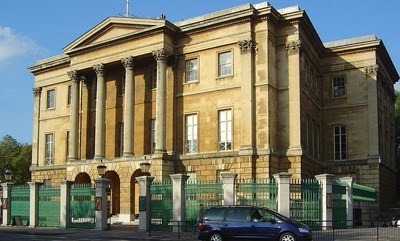
As some of you may be aware, we will be visiting Apsley House during The Duke of Wellington Tour to England in September so I thought I'd pass along the news that Apsley House is currently closed for conservation cleaning (see below) as well as the remodel of the Entry Hall.

I recently learned about the project aimed at transforming the appearance of the Entrance Hall at Apsley House in order to return it to its original designs. Three key aspects to the work include removal of 20th century mosaic tiling, consolidation of the floor sub structure and the reinstatement of the Portland Stone floor and the historic decorative scheme, including specialist finishes. In addition, the reception desk and retail space will be moved to the Inner Hall, where previously there were several marble busts, as well as a table and chairs where visitors could look through books that told the story of the Dukes of Wellington.
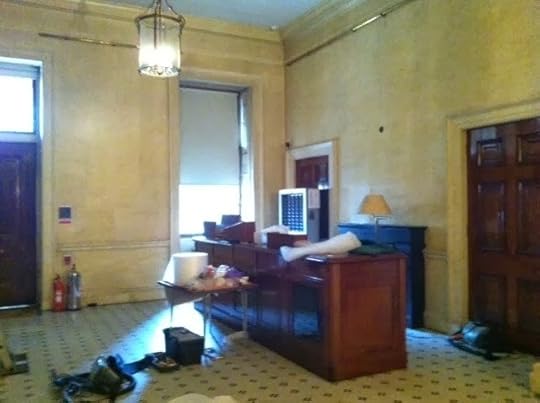
The photo above shows the Entrance Hall before it was stripped out in early November 2013. The 20th century tile mosaic floor has now been replaced with Portland stone, in keeping with the original decor of the 1st Duke of Wellington. The photo above faces the entrance doors to Apsley House. Below is a view of the Hall looking towards the interior of the House. All photos in this post are the property of, and were graciously provided by, Apsley House.
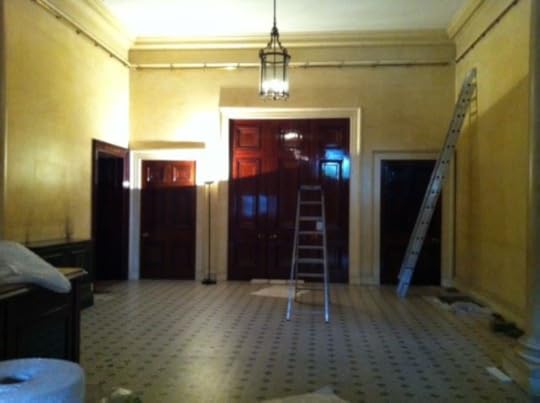
Christopher Small, manager of Apsley House, was kind enough to answer a few questions I had about the remodel and here I pass along his answers to you:
Kristine: Just to be clear, the remodel is going on in what is now the Entrance Hall and not the Inner Hall/Waiting Hall, which was originally the entrance hall - correct?
Christopher: Yes, it is the present entrance hall, which was constructed in the time of the 1st Duke. The Inner Hall, where the ticket desk will now be located, was the original entrance hall in the 18th century Adam House.
Kristine: The 2nd Duke installed the mosaic floor around 1860, but I'm under the impression that it was again altered afterwards. Is that correct?
Christopher: As we understand it the entrance hall mosaic was early 20th century and replaced the 2nd Duke's Victorian mosaic. The inner hall's mosaic is still intact from the 2nd Duke's time.

Above photo: Entrance hall, looking into the Inner Hall
Kristine: Is the plan to return the space to Wyatt's original designs?
Christopher: Although we do not know exactly what the Wyatt entrance hall looked like, this will be a very close approximation.
Kristine: And will this include wall and ceiling treatments, as well as pictures and other decorative items, or just the Portland Stone floor?
Christopher: The floor has been the main piece of work carried out in the restoration, but the walls of both the entrance and inner hall are being re-painted in more authentic style and the marble effect paintwork is being carried out on the columns only this time. In addition, the ceilings have been repainted in white. In terms of pictures on the wall, they will remain pretty much as they were.

Entrance Hall painted and marbling samples being worked out on the columns.
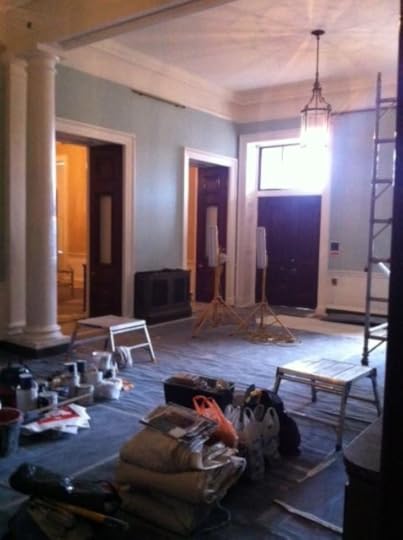
Kristine: How will these changes affect the visitor experience?
Christopher: The admissions desk and retail area will be in the Inner Hall now, as opposed to being in the entrance hall - so that visitors will get that wow factor as they walk into the restored hall. Kristine: Are there plans for further renovations ahead of the anniversary of Waterloo in 2015?
Christopher: There are plans to carry out some restoration work next winter on the furniture into the Waterloo Gallery, and there may even be some new carpets made, as well.
Apsley House will re-open to the public in April. I'm looking forward to seeing the renovations for myself in September. Meanwhile, we can keep up with the progress of the remodel scheme by visiting the Facebook page for Apsley House.
Click Here For Full Details of the Duke of Wellington Tour
Published on February 21, 2014 00:00
February 19, 2014
Video Wednesday - London Hotels
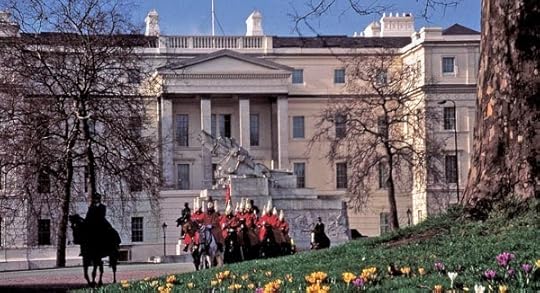
Today we offer video tours of some of London's grandest - and most luxurious - hotels.
The Lanesborough Hotel - Across the street from Apsley House (pictured above)
The recently renovated Savoy Hotel
The Ritz Hotel, Piccadilly
The Royal Horseguards Hotel, Embankment
Claridge's Hotel, Mayfair
The Langham Hotel, Regent Street
The Connaught Hotel, Carlos Place, Mayfair
Published on February 19, 2014 00:00
February 17, 2014
When Queens Collide
Published on February 17, 2014 14:06
On The Shelf - WWII Housewives Diaries
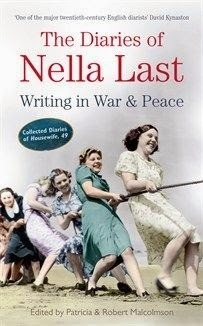
Lately, I've been engrossed in the diaries kept by British housewives during Word War II, the most well known of which is probably The Diaries of Nella Last, a Cumbrian housewife with a talent for writing who chronicled her life and times for the social research organisation Mass Observation, which set out to record everyday life in Britain through the cooperation of about five hundred volunteer observers who agreed to keep regular diary entries. Many other Mass Observation diaries, now held in the Mass Observation Archive at the University of Sussex, ended with the conclusion of World War II. Nella, however, kept sending in her diaries to the Mass Observation office in London and continued writing until 1966 (Nella died in 1968). Her diary, consisting of around 12 million words, is one of the longest in the English language.
On the home front, Nella volunteered in a local canteen and charity shop, amongst other war work. She was an amateur doll maker and took pride in her ability to put tasty meals on the table and to keep house and home together through shortages, rationing and the occasional bombing. Through her war work, Nella's world broadened beyond the boundaries of her house and family - and a husband whose dislike for socializing decidedly cramped Nella's style. Of course, Nella never dreamed that her diaries would be published, and so she wrote from the heart, often worrying, sometimes griping and always with honesty. The Diaries of Nella Last is a compilation of diary entries from all of Nella's published diaries. Other books include Nella Last's Peace, which includes diaries from the post war years, and Nella Last in the 1950's. Click here to read a review of Nella's post war diaries.
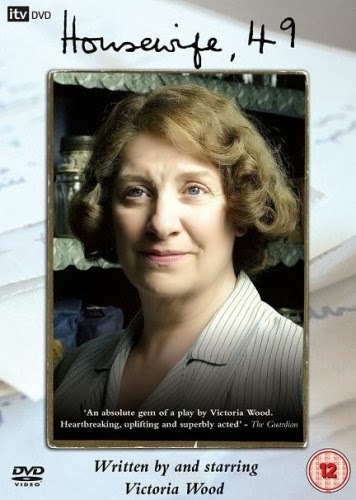
Nella's day to day life is both ordinary and compelling. In 2006, ITV made a film based her diaries called Housewife 49. You can watch a clip of that movie here.
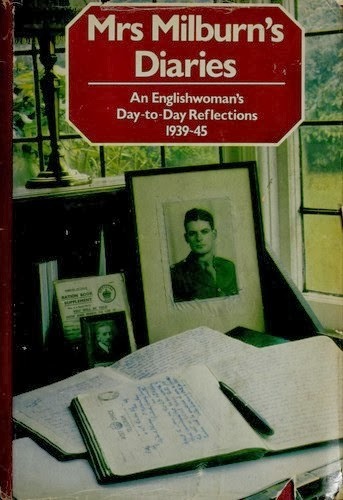
The next diaries I read were Mrs. Milburn's Diaries: An Englishwoman's Day-to-Day Reflections 1939-1945. Clara Milburn and her husband, Jack, have one son, Alan, who was captured at Dunkirk in June 1940 and spent most of the war years as a prisoner of war. Thoughts of Alan dominate these pages and Clara is much more meticulous in recording the actions of the British, American and Russian forces. Less homey than Nella Last's diary entries, Clara Milburn still has the power to involve the reader in her day to day concerns and her entries teeter between war reporting and chatty news:
"Tuesday, 15th July, 1941 - St. Swithin's Day - and there were several showers! There was also a letter from Alan from Stalag XXA, dated 30th May, when he was very well and said they were probably going to move again: `Actually we have enjoyed our stay here.' He really is amusing and seems to enjoy whatever comes! I am getting his parcel together as I want it to go as soon as I get definite confirmation that he is at Oflag 1XA.
"It is good to know that an armistice with Syria is signed and sealed, so that fighting has ended, but it cost us 1,500 men. We are now definitely allied to Russia. They are fighting well and giving the Germans hard work for their advance into Russia - not far yet."
And then
"Tuesday, 17th March, 1942 - A letter from Alan. He sounds well and busy. I went off to Coventry in the car at 10.30 and at two minutes to 11 arrived at the Bishop's house, parked the car safely and spent an enjoyable day hearing M.U. business. Afterwards called on several people, including Katie Bluemel and her mother, and heard of their burglary. A man called saying there was trouble with the main electricity connection outside and could he just look at their plugs and other electric fires, etc. After he had been upstairs a little while (and Katie went up with him first), he came down, knocked on the sitting-room door, thanked her and went away. Later in the evening two cases of jewelry were found to be missing and, a few days later, two fur coats as well. The latter were probably thrown out of the window into a side lane."
There are three more war diaries on my "to be read" list, the first being World War II London Blitz Diary -Volume I and II: A Woman’s Revelations Enduring War and Marriage Written by London housewife Ruby Thompson. A description from Amazon:
From the AuthorGreat Granddaughter of Ruby Alice Thompson Side - I inherited a set of 43 diaries that span from 1909 - 1969. They were given to my grandmother Ruth Ferris Thompson and she passed them down to me. I started re-reading the World War ll journals and found them extremely worthy of note on many levels. I realized how little I knew about the events surrounding World War ll and what the Londoner's in particular had to endure. These journals are a combination of the historical and the exceptionally personal.
I thought that others may also find them intriguing and started a blog. In doing so I received reactions from people from around the world and this inspired me to publish them in book form for all to enjoy.
About the AuthorRuby Side Thompson, an ordinary woman living during the World War ll London Blitz bombing blasts history out of the realm of dry, dusty names and dates and places the reader in the midst of the terrifying events as they unfold. This is very important documentation and will have tremendous appeal to those who have an avid interest in the effect of the war on ordinary citizens.
In between the lines there is a glimpse of how life must go even in Britain-at-war as she deals with health issues, in-laws, censors, rationing and fashion. An excellent look at one woman's view of World War II from before the war to England's darkest hour.Next on my list is War and Peace and the Price of Cat-Fish, "A daily diary kept by ‘Uncle Fred’ which follows a family living in south London – full of lots of interesting domestic detail as well as how the war affected everyone." You can read the diary online here. Also online are May Hill's WWII Diaries . From the website: "May Hill’s previously quiet English seaside village became an unwitting target for enemy aircraft, her only son a young volunteer in the RAF, her husband a Coastguard, and close family members early casualties. In rare moments of peace from ‘her own old enemy’ she became devoted to writing."Decades later, a fading old school exercise book, found hidden away in a forgotten drawer, began a family project of search and research. When, after several more years, the final cache of ‘missing’ diaries unexpectedly came to light, so did a wonderful surprise collection of May’s original poetry."A few years ago, the BBC ran an eight part program called Wartime Farm, in which three modern day scholars recreate what it was like to live and farm in Hampshire during WWII using period methods, equipment, recipes, etc. You can watch the first part on YouTube at the link above.
Do you know of any first hand, home front accounts of Britain during WWI or WWII? If so, please let us know by leaving a comment on this post - thank you!
Published on February 17, 2014 00:00
February 14, 2014
In Honor of Valentine's Day
Britain, the magazine of the British Tourist Authority, has chosen the top romantic gestures in British history to celebrate Valentine's Day 2014. We couldn't have put together a better collection -- so here it is: Greatest Romantic Gestures
 The Albert Memorial and Royal Albert Hall
The Albert Memorial and Royal Albert Hall
Kristine and Victoria visited the wonderful exhibition in the Queen's Gallery in 2010 Victoria and Albert: Art and Love, and we were charmed. You can explore it too, by clicking here.
 Queen's Gallery, London, 2010
Queen's Gallery, London, 2010
Read what Kristine and Victoria saw in the exhibition, here.
To all our readers, Happy Valentine's Day. We love you!
 The Albert Memorial and Royal Albert Hall
The Albert Memorial and Royal Albert HallKristine and Victoria visited the wonderful exhibition in the Queen's Gallery in 2010 Victoria and Albert: Art and Love, and we were charmed. You can explore it too, by clicking here.
 Queen's Gallery, London, 2010
Queen's Gallery, London, 2010Read what Kristine and Victoria saw in the exhibition, here.
To all our readers, Happy Valentine's Day. We love you!
Published on February 14, 2014 00:00
February 12, 2014
Video Wednesday - Stately Home Renovations
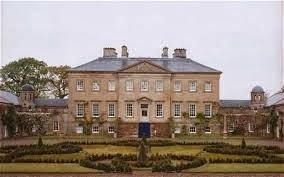 Dumfries House
Dumfries HousePrince Charles - the Royal Restoration of Dumfries House - Documentary 46 minutes.
Tim Wonnacott and Rosemary Shrager visit some of the castles, palaces and stately homes frequented by Queen Victoria during her lifetime. They begin with Chatsworth House in Derbyshire. 30 minutes.
I Own Britain's Best Home - The Yorkshire Castle, a renovated folly. 10 minutes.
Grand Designs - The Dilapidated Georgian House- 55 minutes.
Tour round the interior of abandoned Berkyn Manor. 4 minutes.
Wentworth Woodhouse - the incredible, sinking stately home. 3 minutes.
Restoration Home - Stoke Hall. 49 minutes
Published on February 12, 2014 00:00
February 10, 2014
And From Elsewhere On The Web . . . . .

We thought we'd pass along some interesting posts we've stumbled upon lately - something for everyone. Enjoy!
The Momento Moriatas - Killed By A Coffin, And Other Tales of Kensal Green Cemetery

The British Library Blog - How Research at the British Library led two authors to challenge 18th
century East End stereotypes and to write three books on the subject.
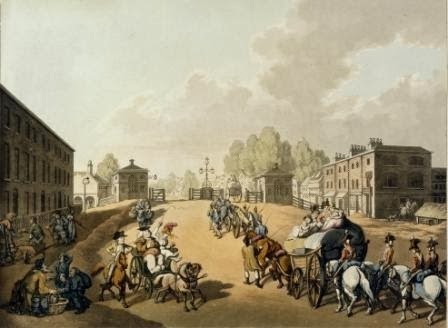
Views of London, No.5. Entrance from Mile End or Whitechaple Turnpike’. Maps.K.Top.22.6.e - S
The Georgian Gentleman - London's first gas lights
The Guardian - Inside "Billionaires Row": London's rotting, derelict mansions worth 350m
Adventures in Historyland - Lady Butler's Waterloo
Published on February 10, 2014 00:00
Kristine Hughes's Blog
- Kristine Hughes's profile
- 6 followers
Kristine Hughes isn't a Goodreads Author
(yet),
but they
do have a blog,
so here are some recent posts imported from
their feed.




